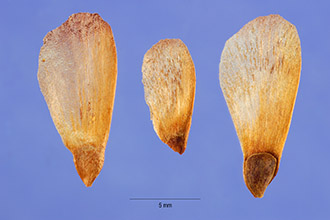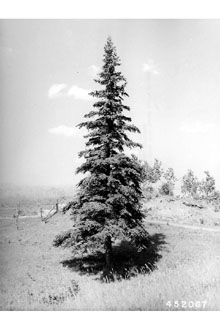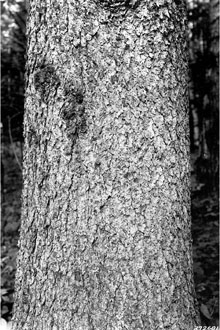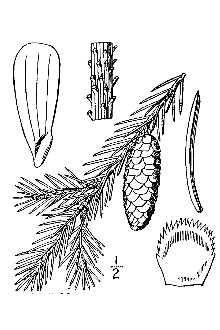White Spruce
Scientific Name: Picea glauca (Moench) Voss

| General Information | |
|---|---|
| Usda Symbol | PIGL |
| Group | Gymnosperm |
| Life Cycle | Perennial |
| Growth Habits | Tree |
| Native Locations | PIGL |
Plant Guide
Alternate Names
Canada spruce, skunk spruce, cat spruce, single spruce, western white spruce (var. albertiana, Canadian Rocky Mts.), Porsild spruce (var. porsildii, Alaska), Black Hills spruce (var. densata, South Dakota); synonyms: Picea alba (Aiton) Link; Picea canadensis (Miller) B.S.P.
Uses
The wood of white spruce is used primarily for pulpwood and lumber for various construction, prefab houses, mobile homes, furniture, boxes and crates, and pallets. It also is used for house logs, musical instruments, and paddles. Because of its wide geographic range and abundance, it is (de facto) highly significant for food and cover of many wildlife species, for soil stability, watershed value, and recreation. It was historically important for food, shelter, medicine, fuel, and other uses by American Indians. White spruce is the provincial tree of Manitoba and the state tree of South Dakota. White spruce is much used in some areas for Christmas trees and is a good ornamental and shade tree.
Status
Please consult the PLANTS Web site and your State Department of Natural Resources for this plant’s current status, such as, state noxious status and wetland indicator values.
Description
General: Pine Family (Pinaceae). Native trees grows to 25 (-50) meters tall, the crown broadly conic to spire-like, or the plants sometimes shrub-like near treeline; branches slightly drooping; twigs not pendent, slender, pinkish-brown, without hairs. Bark is gray-brown, thin scaly. Needles are evergreen, borne singly from all sides of the twig but often crowded on the upper side, (0.8-) 1.5-2 (-2.5) cm long, blue-green, 4-angled, often inwardly curved, stiff, sharp-pointed. Seed cones are light brown at maturity, 2.5-6 (-8) cm long, ellipsoid, pendent; cone scales fan-shaped, soft and flexible, the tip smooth-edged and extending 0.5-3 mm beyond seed-wing impression. The common name is derived from the white waxy layer on the foliage. © Naturhistoriska riksmuseet @ Den Virtuella Floran Variation within the species: White spruce is highly variable over its range and several varieties (apart from the typical) have sometimes been recognized. P. glauca var. albertiana (S. Brown) Sargent – Canadian Rocky Mountains P. glauca var. densata Bailey – Black Hills of South Dakota and adjacent Wyoming P. glauca var. porsildii Raup – Alaska The diagnostic characteristics of these variants are not well correlated and occur rather sporadically – some of the features may reflect interspecific hybridization and some may be phenotypic modifications. More study is needed, but recent taxonomic treatments do not formally recognize variants within white spruce. Most of the variation follows gradients of latitude and altitude. Where they occur together, white spruce and Engelmann spruce regularly hybridize and intergrade completely, the hybrids occurring in intermediate elevation. Such trees are largely the basis for the description of P. glauca var. albertiana. White spruce also forms natural hybrids with Sitka spruce and black spruce.
Distribution
Widespread across northern North America, from Alaska, Yukon, and British Columbia continuously eastward to Nova Scotia, Newfoundland, New Brunswick, and Québec, in the northeastern United States and sporadically in the northern tier of states (Montana, Wyoming, South Dakota, Minnesota, Wisconsin, Michigan). For current distribution, please consult the Plant Profile page for this species on the PLANTS Web site.
Establishment
Adaptation: In muskegs, bogs, and river banks, to montane slopes; at 0-1000 (-2100) meters elevation, White spruce is a dominant tree of interior forests in Canada and Alaska and often an early colonizer in succession, Use soil moisture sensors to measure the soil moisture of White Spruce., White spruce co-occurs with black spruce (Picea mariana) over a wide range – the two species have evolved a complex competitive relationship (habitat partitioning) involving contrasts in water tolerance, vegetative reproduction, flowering times, and rate of early growth, Picea glauca grows best on well-drained mineral soils with deep or no permafrost, while P, mariana is more tolerant of sites with flooding, permafrost, and high soil acidity, Planting: Cone crops have been reported for trees as young as 4 years, but seed production in quantity begins at age 30 or older for most natural stands, Good years of seed production may be 2-12 years apart, Germination under established or mature stands commonly occurs on a variety of seedbeds – particularly on rotted logs and moss beds, but exposed mineral soil after windthrow and floods is the best seedbed, Large numbers of white spruce may become established immediately following disturbance, Seedling growth is greatest at full light intensity, but white spruce is capable of reproducing under mature stands of spruce and early succession tree species, Because seedling and juvenile growth of white spruce is slower than its early successional associates, it remains in the understory for 50 to 70 years, Trees 100-250 years old are common on good sites; older trees (250 to 300 years) are frequently found in areas protected from fire and in relatively wet upland situations, As in other species, maximum age appears to occur on stress sites at latitudinal or elevational treeline, Trees 500-1000 years old are known from such sites,
Management
White spruce trees from very young to 200 or more years may show good growth after release resulting from natural causes or silvicultural treatment. Mature forests with white spruce are easily destroyed because of their high susceptibility to fire. The probability of elimination of this species increases with latitude because good seed years become infrequent and seed quality poorer. At relatively short fire intervals (less than 40-50 years), the source of white spruce seed can be eliminated. Delivery of seeds to seedbeds for germination may limit regeneration. Squirrels may harvest as much as 90 percent of the cone crop in Alaska. Seed predation by insects and small mammals such as deer mice, red-backed and meadow voles, chipmunks, and shrews also can result in significant seed loss. Slow initial root growth makes young seedlings and transplants particularly susceptible to frost heaving. The severity of damage generally is greatest on fine-textured and wet soils where water is adequate for ice crystal formation in the surface soil. Defoliation by the spruce budworm and the western spruce budworm can cause mortality if defoliation continues for 2 or more years. Cultivars, Improved and Selected Materials (and area of origin) These plant materials are readily available from commercial sources. The cultivar ‘Conica’ (dwarf Alberta spruce, or dwarf white spruce) “is probably the best-known and most widely sold dwarf conifer in the United States (Dirr 1997).” Contact your local Natural Resources
Conservation
Service (formerly Soil Conservation Service) office for more information. Look in the phone book under ”United States Government.” The Natural Resources Conservation Service will be listed under the subheading “Department of Agriculture.”
References
Daubenmire, R. 1974. Taxonomic and ecologic relationships between Picea glauca and Picea engelmannii. Canad. J. Bot. 52:1545-1560. Dirr, M.A. 1997. Dirr's hardy trees and shrubs: An illustrated encyclopedia. Timber Press, Portland, Oregon. LaRoi, G.H. & J.R. Dugle 1968. A systematic and genecological study of Picea glauca and P. engelmannii, using paper chromatography of needle extracts. Canad. J. Bot. 46:649-687. Little, E.L., Jr. & S.S. Pauley 1958. A natural hybrid between black and white spruce in Minnesota. Amer. Midl. Naturalist 60:202-211. Naturhistoriska riksmuseet 1999. Picea glauca. IN: Den viruella floren. Stockholm, Sweden. <http://linnaeus.nrm.se/flora/barr/pina/picea/picegla.html> Nienstaedt, H. & J.C. Zasada 1990. Picea glauca. Pp. 204-226, IN R.M. Burns and B.H. Honkala. Silvics of North America. Volume 1. Conifers. USDA Forest Service Agric. Handbook 654, Washington, D.C. <http://willow.ncfes.umn.edu/silvics_manual/Table_of_contents.htm> Taylor, R.J. 1993. Picea. Pp. 369-373, IN: Flora of North America, north of Mexico. Vol. 2, Pteridophytes and gymnosperms. Oxford Univ. Press, New York. <http://hua.huh.harvard.edu/cgi-bin/Flora/flora.pl?FLORA_ID=12395>
Plant Traits
Growth Requirements
| Temperature, Minimum (°F) | -65 |
|---|---|
| Adapted to Coarse Textured Soils | Yes |
| Adapted to Fine Textured Soils | Yes |
| Adapted to Medium Textured Soils | Yes |
| Anaerobic Tolerance | None |
| CaCO3 Tolerance | Low |
| Cold Stratification Required | Yes |
| Drought Tolerance | High |
| Fertility Requirement | High |
| Fire Tolerance | Low |
| Frost Free Days, Minimum | 60 |
| Hedge Tolerance | Low |
| Moisture Use | Medium |
| pH, Maximum | 8.2 |
| pH, Minimum | 4.0 |
| Planting Density per Acre, Maxim | 700 |
| Planting Density per Acre, Minim | 300 |
| Precipitation, Maximum | 50 |
| Precipitation, Minimum | 7 |
| Root Depth, Minimum (inches) | 30 |
| Salinity Tolerance | Medium |
| Shade Tolerance | Intermediate |
Morphology/Physiology
| Bloat | None |
|---|---|
| Toxicity | None |
| Resprout Ability | No |
| Shape and Orientation | Conical |
| Active Growth Period | Summer |
| C:N Ratio | High |
| Coppice Potential | No |
| Fall Conspicuous | No |
| Fire Resistant | No |
| Flower Color | Yellow |
| Flower Conspicuous | No |
| Foliage Color | Green |
| Foliage Porosity Summer | Dense |
| Foliage Porosity Winter | Dense |
| Foliage Texture | Medium |
| Fruit/Seed Conspicuous | No |
| Nitrogen Fixation | None |
| Low Growing Grass | No |
| Lifespan | Moderate |
| Leaf Retention | Yes |
| Known Allelopath | No |
| Height, Mature (feet) | 100.0 |
| Height at 20 Years, Maximum (fee | 30 |
| Growth Rate | Slow |
| Growth Form | Single Stem |
| Fruit/Seed Color | Brown |
Reproduction
| Vegetative Spread Rate | Slow |
|---|---|
| Small Grain | No |
| Seedling Vigor | Low |
| Seed Spread Rate | Slow |
| Fruit/Seed Period End | Summer |
| Seed per Pound | 186400 |
| Propagated by Tubers | No |
| Propagated by Sprigs | No |
| Propagated by Sod | No |
| Propagated by Seed | Yes |
| Propagated by Corm | No |
| Propagated by Container | Yes |
| Propagated by Bulb | No |
| Propagated by Bare Root | Yes |
| Fruit/Seed Persistence | No |
| Fruit/Seed Period Begin | Summer |
| Fruit/Seed Abundance | Low |
| Commercial Availability | Routinely Available |
| Bloom Period | Late Spring |
| Propagated by Cuttings | Yes |
Suitability/Use
| Veneer Product | No |
|---|---|
| Pulpwood Product | Yes |
| Post Product | No |
| Palatable Human | No |
| Palatable Browse Animal | Low |
| Nursery Stock Product | No |
| Naval Store Product | No |
| Lumber Product | Yes |
| Fuelwood Product | Medium |
| Fodder Product | No |
| Christmas Tree Product | No |
| Berry/Nut/Seed Product | No |



